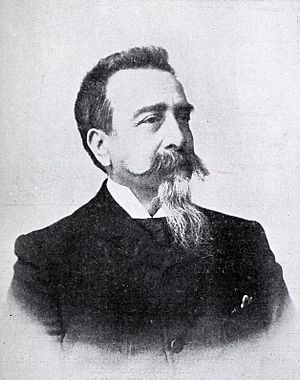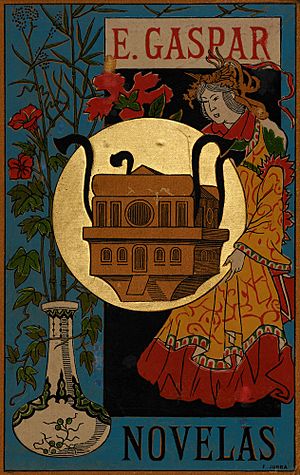Enrique Gaspar facts for kids
Enrique Lucio Eugenio Gaspar y Rimbau (born March 2, 1842, in Madrid – died September 7, 1902, in Oloron, France) was a Spanish diplomat and writer. He wrote many plays, including musical ones called zarzuelas. He is also famous for writing one of the very first novels about time travel using a machine, called El anacronópete.
Contents
Enrique Gaspar's Early Life and Career
Enrique Gaspar y Rimbau was born to parents who were well-known actors. After his father, Juan, passed away, Enrique moved to Valencia with his mother and two siblings. He studied humanities and philosophy, but he didn't finish his studies. Instead, he started working at a commercial bank.
He began writing at a very young age. By the time he was 13, he had already written his first zarzuela. At 14, he was a writer for a magazine called La Ilustración Valenciana. When he was 15, his mother even put on a performance of his first comedy play. He moved to Madrid at age 21 to focus completely on writing.
His most active years as a writer were from 1868 to 1875. During this time, he wrote plays and operas for the general public. He also wrote historical dramas and was a pioneer in social theatre in Spain. He had great success with his comedies. However, his true passion was writing about social issues, like promoting education for women and encouraging meaningful marriages. These plays were not as popular at the time because their ideas were ahead of their time.
When he was 23, Gaspar y Rimbau married Enriqueta Batllés y Bertán de Lis. She was from a noble family, and her parents were not happy about the marriage. After their second child was born, Enrique joined the diplomatic service at age 27.
Life as a Diplomat and Later Years
Enrique Gaspar worked as a diplomat in several places. He spent time in Greece and France, then returned to Madrid. Later, he served as a consul in China, first in Macau and then in Hong Kong. Even while working as a diplomat, he continued to write and put on plays. He also wrote for a newspaper called El Diario de Manila.
After returning to Europe, he moved to Oloron in the south of France. His family lived in Barcelona, where he even put on a play in the Catalan language. Later, he lived in different places in southern France. His wife passed away in Marseille, where he was serving as consul.
Enrique's own health was not good. He retired to Oloron to live with his daughter, son-in-law, and grandchildren. He passed away there in 1902 at the age of 60.
El anacronópete: A Time Travel Adventure
El anacronópete was published in 1887 in Barcelona. The title is a made-up word that means "who flies against time." This novel has become one of Gaspar y Rimbau's most important works. It is a Spanish science fiction novel. It was published before The Chronic Argonauts by H. G. Wells in 1888, which was Wells's first story about time travel using a machine.
The novel is written like a zarzuela, a Spanish musical play. It is one of the first stories to feature a machine that travels through time. This machine is called the 'anacronópete'. It is a huge cast iron box powered by electricity. It has four large devices that help it travel and also power other machines inside. One special machine produces a "García fluid" that stops the passengers from getting younger as they travel backward in time. The machine's inside also has many cool features, like brooms that sweep by themselves!
The story of El anacronópete happens in three acts. A group of characters travels through time in the machine:
- Don Sindulfo García: A scientist from Zaragoza and the inventor of the machine.
- Benjamín: His friend and assistant.
- Clarita: Don Sindulfo's niece.
- A maidservant.
- Captain Luis: Clarita's true love.
- Several Spanish soldiers called hussars.
- A group of older French women that the mayor of Paris wants to make young again.
Act One: Traveling Backwards
In the first act, don Sindulfo explains his idea about time. He believes that the atmosphere causes time to pass, just like how food stays fresh in sealed cans. He thinks that by flying very fast against the rotation of Earth, the machine can "undo" the passing of days.
They leave Paris from the World's Fair of 1878. Their first stop is the Battle of Tetuán in 1860. Here, Captain Luis's soldiers, who Clarita hoped would protect her, turn into children and disappear. This happens because they were not protected by the "fluid of inalterability." The machine then returns to Paris the day before they left, and some of the "rejuvenated" French women get off.
Act Two: Seeking Immortality
In the second act, they travel further into the past, looking for the secret to immortality. They stop at different times in history. They visit Granada in 1492, where they advise Queen Isabella to listen to Christopher Columbus. They also stop in Ravenna in 690 to get supplies.
Their journey takes them to Ho-nan, China, in the year 220. Don Sindulfo hopes to force Clarita to marry him there. The emperor Hien-ti shows the travelers that many inventions, like the printing press and iron ships, are already known in his time. The emperor's wife, Sun-Che, has just died. He offers to trade the secret of immortality for Clarita.
It turns out that the empress had been buried alive by her husband. She is actually the same Chinese mummy that Sindulfo had bought and brought into the machine! She becomes free and wants to marry Sindulfo. The characters change during this journey: Benjamín becomes obsessed with eternal life, don Sindulfo becomes very jealous over Clarita, and Clarita falls in love with Captain Luis. Benjamín discovers that the disappeared soldiers have reappeared because their spirits stayed in the anacronópete. He also realizes that Sindulfo's first wife was the same as the empress through metempsychosis (the idea of a soul moving into another body). As they leave, Tsao Pi starts the Ouei dynasty.
Act Three: The End of Time
In the third act, they stop in Pompeii during the Vesuvius eruption in the year 79. Then, they travel all the way back to the 30th century BCE, the time of Noah. There, they discover that the secret of eternal life is God. Finally, don Sindulfo, in his madness, speeds up the anacronópete. The machine explodes when it reaches the Day of Creation.
Don Sindulfo then wakes up. He realizes he had fallen asleep while watching a play by Jules Verne. Luis and Clarita are there, happily married. It was all a dream!
Enrique Gaspar wrote El Anacronópete while he was working as a diplomat in China (from 1878 to 1885). The novel fit well with the popular ideas of the time, especially with the success of Jules Verne's adventure stories. It was likely influenced by his friend Camille Flammarion and Flammarion's story Lumen, which featured spiritual time travel. El Anacronópete was written in 1881, so it came before another similar work, L'historioscope by Eugène Mouton.
The first edition of the book was published by Daniel Cortezo and had illustrations by Francesc Soler. It has been republished several times since then.
Selected Works
- La nodriza, Madrid 1876
- Atila, Madrid, 1876
See also
In Spanish: Enrique Gaspar para niños



